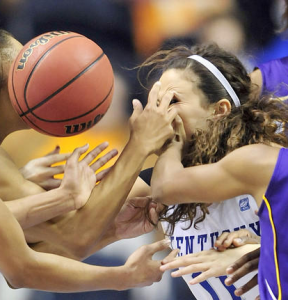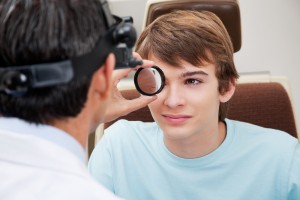
(Photo credit: Baltimore Sun)
A patient’s visit for an eye exam serves as a cautionary tale on the importance of eye protection in sports. Retired now, the patient was a former standout college basketball star who went on to play ball overseas for a number of years. He made the eye appointment because he felt his vision was declining more rapidly than it should have been for someone his age. It had also been more than two years since he had had an eye exam. At the time of his visit, the patient was in his mid-30’s but reported that his vision was blurry and his peripheral vision, which had always been keen in his playing days, seemed diminished.
The patient’s eye exam revealed that he had open-angle glaucoma. Discussion with the patient about his overall health and previous eye issues revealed that he had received treatment many times for pokes in the eye while playing sports, including a diagnosis of hyphema when he was in high school. Hyphema is bleeding in the front portion of the eye that results most often from a trauma, and sometimes is the result of a sports injury. It’s an injury that can lead to premature cataract formation or glaucoma.
The ophthalmologist proposed medications to treat the glaucoma and discussed surgical treatments if the glaucoma progressed to the point where surgery was the only option for preventing further loss of vision. Regular eye exams to check eye pressure and progression of the glaucoma were also prescriptions the patient needed to follow to maintain his eye health.
Eye Injury Risks and Sports
Often, as was the case with this patient, we find that many people involved with sports (whether they are players, coaches, or parents), do not realize the importance of eye protection, especially for children. Wearing sports glasses to prevent eye injury, particularly for children who already wear corrective lenses or eye glasses, is an important measure for parents to take. And parents and guardians should be sure their children are receiving regular vision screening at their school. If it has been more than two years since your child’s last eye exam and he or she is active in sports, make an appointment at ECI. For children and young adults who’ve already sustained an eye injury, we recommend they wear protective sports eyewear or sports goggles to help prevent further damage to their eyes. Children and adults who wear sports glasses due to an eye injury should also have an eye exam every year.

- Infants: Pediatrician screening at 6 months
- Preschool children: Pediatrician screenings from age 3 to 6
- School-age children: Regular vision screenings at school
- Adults: Every 2 years
- Adults over 60: Annually
If your child’s pediatrician, coach, or school personnel suspect he or she has sustained an eye injury, or if you have a history of eye disease or eye problems in your family, make an appointment for your child to have a full eye exam by our optometrist or one of our ophthalmologists.